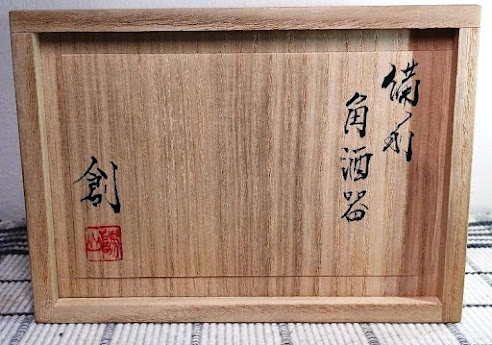254. ISEZAKI Sō 伊勢崎創, 1968- , Bizen kaku shuki 備前角酒器 (Bizen-ware squared sake server and cup)
Isezaki Sō comes from a prominent family of potters in the Bizen tradition (his uncle Isezaki Jun is a Living National Treasure). He is the third son of the important potter Isezaki Mitsuru and was raised alongside the family kiln. At eighteen he apprenticed under Bizen master Yamashita Jōji and was first exhibited the following year. After his twentieth birthday he went to the United States for study. Upon returning to Japan, he won the first of many awards at the Okayama Kenten (Okayama Prefectural Art Exhibition). He then returned to the United States for another year of study. The American influences are apparent in his non-traditional approach to design. He has exhibited and received awards at the Nihon Dentō Kōgei Ten (Traditional Crafts Exhibition), the Tobiten of the Japan Ceramic Art Society, and the Tanabe Museum Modern Forms in Tea Exhibition, among others. For other examples of his work, see his website (SO ISEZAKI).
Gray clay. Fired unglazed; surface colors in the red, tan, and brown ranges, with red veins of hidasuki 緋襷 (scarlet cords), with areas of vitrification. Server. Weight (without lid and handle): 396 g (14 oz). Height (of ceramic only): 7.2 cm (2-7/8 in). Length (overall): 13.8 cm (5-1/2 in). Width: 7.5 cm (3 in). Cup. Weight: 132 g (4.7 oz). Dimesions of cube: 5 x 5 x 5 cm (2 x 2 x 2 in).
Both the server and the cup are squared off and angular in shape. The server has a wooden lid and a removable brass handle. The server is a rectangular box, with an attached spout and two semicircles that serve as anchoring points for the handle, one in the upper center of the back side and one at the front of the top side just aft of the spout. The box proper is 6.5 cm (2-5/8 in) high; 9.7 cm (3-7/8 in) long, and 7.5 cm (3 in) wide. The lower edges of the sides are beveled inwards at about a 30-degree angle to form a flat rectangular base, 5.8 x 8.2 cm (2-5/16 x 3-1/4 in), about 0.6 cm (1/4 in) high. The artist’s sigil is incised into the center of the base. The two anchoring points for the handle are 2.5 cm (1 in) wide and 1 cm (3/8 in) high. The spout is a right triangle set flush with the top side of the box and located in the upper center of the front side. It is 3.1 cm (1-1/4 in) high, 2.7 cm (1-1/8 in) long, and 1.5 cm (5/8 in) wide. The pouring hole is a rectangle. The opening on the top of the box is another rectangle, located at the rear of the piece, 6.6 x 4.8 cm (2-5/8 x 1-7/8 in) in size. The lid is made of a fine-grained wood, 7.4 cm (2-15/16 in) square. The underside of the lid has a protruding rectangular piece slightly smaller than the hole in the top of the box that serves to anchor the lid on the box. The surface texture if the piece is slightly rough, like a fine-grained sandpaper.
The cup is a rough cube, with irregular top edges. The bottom edges of the sides are beveled inwards at about a 45-degree angle. The cup sits on a flat base, roughly 4.2 cm (1-5/8 in) square. The center of the base is a shallow, squarish depression of irregular depth (at most one mm deep). The artist’s sigil is incised in this area of the base. The walls of the cup are covered with a series of very shallow striations, angling toward the left. The texture of the cup ranges from very smooth in the areas covered by vitrified ash glazing to slightly rough in the uncovered portions.
These were fired unglazed. Both pieces show the red hidasuki veins, produced by the interaction between rice straw and the Bizen clay. These are found on the bottom of the server and the bottom and sides of the cup. The bottoms of both pieces are otherwise largely the natural color of the clay. On the sides, kiln effects left colors in the tan, reddish brown, and dark brown ranges. On the server, the back side and the two long sides have large areas of vitrification from natural ash glazing. The sides of the cup are mostly covered with vitrified ash glazing. In some places this layer is quite heavy and thick.
This came in a well-constructed, two-chamber box. The front of the box was inscribed by Isesaki in three lines: 備前 / 角酒器 / 創 Bizen / kaku shuki / Sō (Bizen-ware / square sake set / Sō), followed by the artist’s seal in red. Included in the box were a small printed biography and two dark blue wrapping cloths.
Purchased from the Kura Monzen Gallery in Kyoto, Japan, in June 2024 (invoice, shipping and customs documents).








































